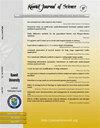Molecular cloning, characterization and expression analysis of cinnamate 4-hydroxylase (C4H) from Ferula pseudalliacea
IF 1.1
4区 综合性期刊
Q3 MULTIDISCIPLINARY SCIENCES
引用次数: 0
Abstract
Cinnamate 4-hydroxylase (C4H) is a key enzyme in the phenylpropanoid pathway, catalyzing the hydroxylation of trans-cinnamic acid to p-coumaric acid. However, there is very limited information on the function of C4H in medicinal plants. In the present study, the C4H gene from the Ferula pseudalliacea genome (named FpC4H) was cloned and characterized. Besides, the expression levels of FpC4H in the roots, stems, leaves, flowers, and immature fruits were investigated via real-time PCR (polymerase chain reaction). FpC4H showed the most similarity with C4H proteins from Daucus carota. The results predicted that FpC4H, as well as its orthologs, is an unstable and hydrophilic protein. A high genetic distance was observed between FpC4H and C4H from monocots based on evolutionary analysis. A variable region related to the variable function of C4H was detected in the conserved domain region of C4H proteins. Protein structure analysis revealed that isoleucine and leucine residues are frequently present in the binding region of FpC4H, and two ion binding regions, cysteine258 and asparagine217, were identified in the 3D structure of FpC4H. Expression analysis revealed that the FpC4H gene is expressed in all organs of F. pseudallicea. A low expression level of FpC4H was recorded in leaves, and a high expression level was observed in flower. Based on the expression profile, FpC4H seems to be linked to a high content of phenolic compounds in flowers. In future studies related to metabolic engineering, FpC4H with a promoter linked to specific tissues (flowers and roots) could be investigated for improving the content of the phenolic compounds.
伪阿魏肉桂酸4-羟化酶的克隆、表征及表达分析
肉桂酸4-羟化酶(C4H)是苯丙酸途径的关键酶,催化反式肉桂酸羟基化生成对香豆酸。然而,关于C4H在药用植物中的作用的信息非常有限。本研究从假alliacea阿魏(Ferula pseudoalliacea)基因组中克隆了C4H基因(命名为FpC4H)并对其进行了鉴定。通过实时荧光定量PCR (real-time PCR, polymerase chain reaction)检测FpC4H在根、茎、叶、花和未成熟果实中的表达水平。FpC4H与胡萝卜中的C4H蛋白最相似。结果表明,FpC4H及其同源物是一种不稳定的亲水性蛋白。单子叶植物FpC4H与C4H具有较高的遗传距离。在C4H蛋白的保守结构域中检测到与C4H的可变功能相关的可变区域。蛋白质结构分析表明,FpC4H结合区经常存在异亮氨酸和亮氨酸残基,并在FpC4H的三维结构中鉴定出半胱氨酸258和天冬酰胺217两个离子结合区。表达分析显示FpC4H基因在假单胞菌的所有器官中均有表达。FpC4H在叶片中低表达,在花中高表达。基于表达谱,FpC4H似乎与花中酚类化合物的高含量有关。在未来与代谢工程相关的研究中,可以研究FpC4H与特定组织(花和根)连接的启动子,以提高酚类化合物的含量。
本文章由计算机程序翻译,如有差异,请以英文原文为准。
求助全文
约1分钟内获得全文
求助全文
来源期刊

Kuwait Journal of Science
MULTIDISCIPLINARY SCIENCES-
CiteScore
1.60
自引率
28.60%
发文量
132
期刊介绍:
Kuwait Journal of Science (KJS) is indexed and abstracted by major publishing houses such as Chemical Abstract, Science Citation Index, Current contents, Mathematics Abstract, Micribiological Abstracts etc. KJS publishes peer-review articles in various fields of Science including Mathematics, Computer Science, Physics, Statistics, Biology, Chemistry and Earth & Environmental Sciences. In addition, it also aims to bring the results of scientific research carried out under a variety of intellectual traditions and organizations to the attention of specialized scholarly readership. As such, the publisher expects the submission of original manuscripts which contain analysis and solutions about important theoretical, empirical and normative issues.
 求助内容:
求助内容: 应助结果提醒方式:
应助结果提醒方式:


